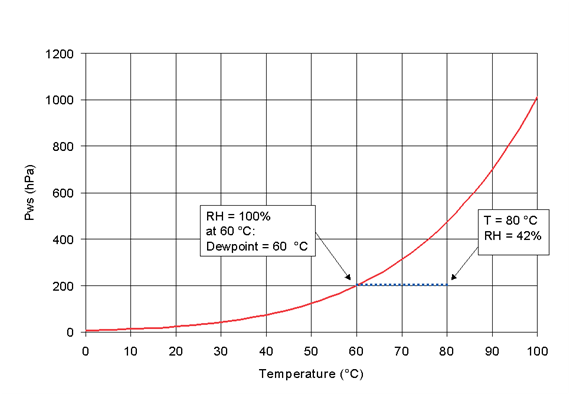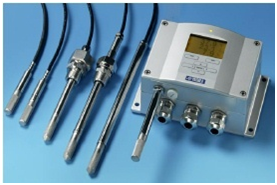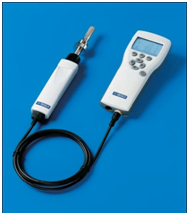Relative Humidity, Dewpoint, Mixing Ratio…. The Many Faces of Water Vapor
Water is known by different names in different states. It can also be measured in many ways and described with various terms. The following article explains the behavior of water vapor in air and clarifies the terminology used to describe it.
It is said that a beloved child has many names. This also applies to water, including water in gaseous form, which is the source of all life on our planet. Most of us have heard of relative humidity and dewpoint temperature, but there are many other ways to measure the presence of water. Partial water vapor pressure, absolute humidity, frostpoint, mixing ratio, wet bulb temperature and even enthalpy all describe the humidity of a gas.
When the term humidity is used, we usually mean water vapor in a gas, typically air. Moisture, on the other hand, is used for liquids and solid materials. The term moisture also applies to extremely dry gases, when water vapor is considered an impurity.
Properties of Gas Mixtures
A full understanding of the various terms for humidity and moisture requires some basic knowledge about the properties of gas mixtures.
In a gas mixture such as air, the total pressure (same as atmospheric or barometric pressure) of the gas is the sum of all the individual pressures of its gas components. The atmospheric pressure, usually around 1000 hPa, is the total of the partial gas pressure of nitrogen (~775 hPa), oxygen (~205 hPa), water vapor (~10 hPa), argon (~10 hPa) carbon dioxide (~0.4 hPa) and a number of other gases with lower partial pressures. All gases produce the same pressure and volume with the same number of molecules, so the partial pressures also represent the proportion by volume of the various gases. On this basis, 21% of the total volume of dry air is oxygen and around 1% is typically argon.
Water Vapor Pressure pw [hPa, PSI, Pa, mbar, mmHg, inHg, mmH20 or inH2O]
The air temperature dictates the maximum partial water vapor pressure in air, in other words, the water vapor saturation pressure. The ability of water to be in gaseous form is strongly dependent on its temperature (see Figure 1: Water vapor saturation pressure curve). The higher the temperature, the higher the partial pressure of the water vapor. The partial water vapor pressure in the immediate presence of liquid water equals the saturation pressure at that specific temperature.

Figure 1. Water Vapor Saturation Pressure Curve
At 100 °C, the boiling point of water, the water vapor pressure surpasses normal atmospheric pressure. In this light, the boiling point of a liquid is dependent not only on the physical properties of the liquid, but also on the surrounding atmospheric pressure. If the mountain climber made himself a cup of tea on top of Mount Everest, the taste would probably leave something to be desired. The atmospheric pressure at an altitude of 8,800 meters is only about one-third the sea level pressure, so the tea water would boil at well below 70 °C.
Relative Humidity RH [%]
Relative humidity is the most commonly used humidity unit. ‘Relatively’ few people, however, understand what it really means.
The ‘relative’ in relative humidity expresses the relation between the amount of water vapor present and the maximum amount that is physically possible at that temperature. In other words, relative humidity, expressed in per cent, is the partial water vapor pressure in relation to the saturation pressure.
% RH = 100% * (pw / pws)
where:
pw = partial water vapor pressure
pws = water vapor’s saturation pressure
If the maximum amount of water vapor has been reached and more water is introduced into the air, an equal amount of water must transform back to liquid or solid form through condensation. At this point, the air is said to be saturated with water, and the relative humidity is 100%. On the other end of the scale, when there is no water vapor in the air, the relative humidity is 0% whatever the temperature. In other words, relative humidity always lies between 0 and 100%.
As mentioned above, the ability of air to hold water vapor is strongly dependent on temperature. This, of course, means that relative humidity is also strongly temperature dependent. Let’s imagine that the outside temperature on a crisp winter day is -14 °C, and the relative humidity is 60%. As this air enters a building it is heated to +21 °C, but the amount of water remains constant – no water is removed or added to the air in normal ventilation systems. Because of this heating, the saturation pressure of the water vapor rises (i.e. the maximum possible amount of water vapor in the air), but the partial pressure of the water vapor is unchanged. In this case, the relative humidity will drop to 5%, which is usually considered too dry for comfort.
Temperature changes also explain why we can sometimes ‘see our breath’ outdoors. Consider what happens when we stand outside on a cool spring morning, at +7 °C and 80% RH. As we exhale air at about +32 °C and 90% RH, it cools rapidly, reaching the saturation point at around +30 °C. As the cooling continues, excess water vapor condenses into tiny water droplets, which we see as steam or mist.
Dewpoint Temperature Td [°F or °C]
This brings us to another widely used humidity unit: dewpoint temperature (°C or °F). Dewpoint is the temperature where condensation begins, or where the relative humidity would be 100% if the air was cooled. This is readily apparent from the diagram for water vapor, given that dewpoint is just a more intelligible way to express partial water vapor pressure (see Figure 2: Dewpoint of gas at 42% RH).

Figure 2. Dewpoint of gas at 80°C and 42% RH
Even though dewpoint is expressed as a temperature, it correlates with the amount of water vapor in the air, and is therefore not dependent on ambient temperature. Dewpoint temperature is always less than or equal to the actual temperature, with the extremes for normal outdoor air being –30 °C and +30 °C. Dryer and wetter gases can be found in industrial environments, for example, where dewpoints between –100 °C and +100 °C are sometimes measured. Theoretically, the dewpoint temperature can be as low as –273 °C (absolute zero), but at a normal atmospheric pressure it can never exceed 100 °C. When the dewpoint is 100 °C, the air only contains water vapor and no other gas, so the amount of water cannot be raised without increasing the density of the vapor, and hence the pressure.
The water vapor saturation pressure at different temperatures is a known variable, so the dewpoint can be calculated from the relative humidity and temperature. Conversely, if the dewpoint and temperature or relative humidity are known, the missing variable can be calculated.
A glass of beer or any cold drink provides a practical example of dewpoint. Since the glass conducts heat fairly well compared to air, it cools to almost the same temperature as the drink. The air surrounding the glass is then cooled, creating a thin layer of air at nearly the same temperature as the glass. If the temperature of the drink is below the dewpoint temperature of the surrounding air, the air around the glass will become saturated with water and the excess water will condense on the surface of the glass. These small water droplets are called dew.
If the temperature of the drink is above the dewpoint temperature of air, the relative humidity of the air surrounding the glass will be higher than the ambient humidity, but no visible condensation will occur.
Frostpoint Tf [°C or °F]
If the dewpoint temperature is below the freezing point, the term frostpoint is sometimes used. The water vapor saturation pressure of ice is slightly lower than that of water, which must be taken into account when calculating frostpoint. When frost actually forms on a surface, it always occurs at the frostpoint, and not at the dewpoint temperature.
Absolute Humidity a [g/m3 or gr/ft3]
Absolute humidity refers to the weight of water in a certain volume of gas. For example, on a typical summer day (+23°, 55% RH), there are 11.3 grams of water vapor per cubic meter. The density of air varies with pressure, so the absolute humidity depends quite strongly on the gas pressure. In pressurized processes, the pressure must be known in order to calculate absolute humidity from the other humidity variables.
Because absolute humidity provides a reliable idea of the amount of water present, it is fairly widely used.
Mixing ratio x [gr/lb or g/kg]
Mixing ratio defines the weight of water in the volume occupied by one kilogram of dry gas. In other words, 9.6 grams of water would have to be vaporized into a kilogram of air to obtain the same summer air as described in the previous section. The density of air varies with pressure, so the mixing ratio is also dependent on the pressure of the gas. In pressurized processes the pressure must be known in order to calculate mixing ratio from other humidity variables.
Mixing ratio is mainly used for calculating water content when the mass flow of air is known, in ventilation systems, for example.
Wet bulb temperature Tw [°C or °F]
As water evaporates, it consumes heat. This cooling effect depends on the ambient temperature and the difference between the water vapor pressure of the ambient air and the saturation pressure at that temperature. By measuring the cooling effect, it is therefore possible to determine the ambient relative humidity. The cooling effect is measured with a psychrometer, an instrument with two thermometers, one of which is covered by a wet cloth. The reading of this thermometer is called the wet bulb temperature. Wet bulb temperature can also be calculated from the temperature, pressure and relative humidity.
Enthalpy h [kJ/kg or Btu/lb]
Enthalpy is a unit expressing the energy content of a gas. Strictly speaking, it should not be included in this article of humidity units. But as water vapor has a very high specific heat capacity and can be present in air in widely different concentrations, it has a very strong influence on enthalpy.
Enthalpy represents the amount of energy needed to bring a gas to its current from a dry gas at a temperature of 0 °C. Energy is consumed to vaporize the water and raise the temperature of the humid gas. Enthalpy is most commonly used when comparing the heat content of gases in air conditioning and other systems.
Water activity aw
Water activity can be defined as the free moisture available in material as opposed to the chemically bound moisture. In simple terms, water activity is the equilibrium relative humidity created by a sample of material in a sealed air space.
Water activity is used in connection with moisture in oil measurements. It indicates directly if there is a risk of free water formation. With a relative scale from 0 (no water present) to 1 (the oil is saturated with water) it gives a reliable indication how close to the saturation point oil is. The advantage of aw is that the measurement is independent of oil type, age and temperature.
Available as Calculated Variables
Vaisala has a choice of products for measuring relative humidity, temperature and dewpoint. Some products also have built in calculation options to give outputs in terms of other humidity variables mentioned in this article. For example Vaisala HUMICAP® Humidity and Temperature Transmitter Series HMT330 provides the most flexible measurement quantities for humidity. In addition to standard relative humidity and temperature, the HMT330 outputs dewpoint temperature, mixing ratio, absolute humidity, wet bulb temperature, enthalpy, and water vapor pressure, depending on model.
Source: Vaisala

